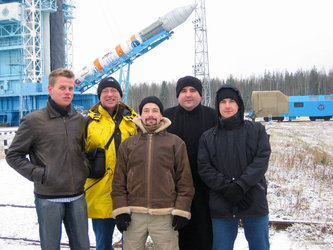Educational CubeSats deployed from SSETI Express
Aboard the SSETI Express satellite, which was launched yesterday morning, were three educational CubeSat satellites each weighing 1kg and measuring 10x10x10cm.
They are:
- Ncube2 from Norway
- XI-V from University of Tokyo in Japan
- UWE-1 from University of Würzburg in Germany

The satellites were successfully deployed from SSETI Express 64 minutes into the mission and so far signals from XI-V and UWE-1 have been successfully received at their respective ground stations.

Ncube2 students are still struggling to receive the first life signs from their satellite.
ESA and the SSETI-Association congratulates the cubesat teams on the successful launch and deployment, and wish them the best of luck for the coming operations.
22:20 - SSETI Express in safe mode

At 22:20 CEST, SSETI Express went into a safe mode due to an undervoltage caused by battery charging problems. The operations team is working actively to resume nominal operations of the satellite and is receiving tremendous help in the process from the amateur radio community. At the time of the anomaly many mission milestones had already successfully been met.
12:50 - SSETI Express in good health
Ground stations all over the world are confirming acquisition of SSETI Express and first reports are that the spacecraft is in good health. The project team are examining the first data and assessing the stability of the mission. Radio amateurs all over the world are excitedly tuning in, hoping to win the SSETI radio amateur competitions.
"SSETI Express is a big success and we congratulate all the students involved for their outstanding effort," said Neil Melville, SSETI project manager from Plesetsk.
9:15 - SSETI Express launched

SSETI Express, the satellite designed and built by European university students, was launched this morning at 08:52 CEST from the Plesetsk Cosmodrome on a Russian Kosmos 3M launcher. First stage ignition and second stage separation completed.
Watch the launch replay















 Germany
Germany
 Austria
Austria
 Belgium
Belgium
 Denmark
Denmark
 Spain
Spain
 Estonia
Estonia
 Finland
Finland
 France
France
 Greece
Greece
 Hungary
Hungary
 Ireland
Ireland
 Italy
Italy
 Luxembourg
Luxembourg
 Norway
Norway
 The Netherlands
The Netherlands
 Poland
Poland
 Portugal
Portugal
 Czechia
Czechia
 Romania
Romania
 United Kingdom
United Kingdom
 Slovenia
Slovenia
 Sweden
Sweden
 Switzerland
Switzerland




























